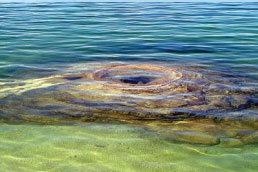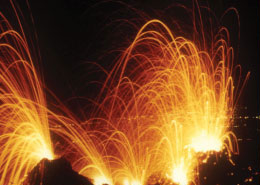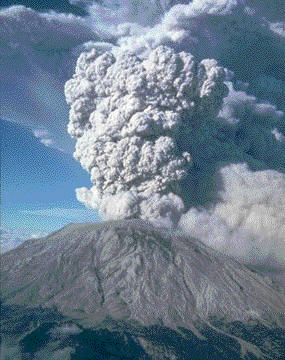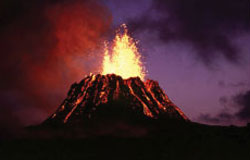|
Natural disasters:
Shapes and sizes of volcanoes
Some of the most active volcanoes in the word:
Continued from last week
K ilauea volcano on Hawaii is the world's most active volcano,
followed by Etna in Italy and Piton de la Fournaise on La Reunion
island. After that, it is difficult to decide the exact order on the
list, but the following are very close: Stromboli, Merapi, Erta Ale, Ol
Doinyo Lengai, Unzen, Yasur, Ambrym, Arenal, Pacaya, Klyuchevsky,
Sheveluch, and Erebus.
|

An underwater mud volcano in the Mayare which has just breached
the surface. |
Mauna Loa, the largest
(area wise) volcano on Earth, it is 60 miles long and 30 miles wide. It
is shaped like a shield, with gently sloping sides because its lava is
extremely fluid (it has low viscosity Mauna Loa is a shield volcano
located on the island of Hawaii. Mauna Loa, which means 'Long Mountain'
in Hawaiian, rises to the height of 13,680 ft. above sea level.
Scientists and geologists estimate that Mauna Loa began erupting
between 700,000 to 1,000,000 years ago and has continued since.
Most of its eruptions have occurred in three regions on the mountain:
at the summit and in two rift zones extending northeast and southwest of
the summit.
The mountain's summit caldera is called Mokuaweoweo which is 1.75 to
three miles in diameter. It is estimated that the caldera was formed
1,000 -1,500 years ago as the outcome of a very large eruption from the
northeast rift zone. It emptied out the shallow magma chamber beneath
the summit, which eventually collapsed. Mauna Loa's most recent eruption
occurred from March 24, 1984 and lasted till April 15, 1984. Since then
the mountain has been dormant.
The main volcanic hazard
Mauna Loa presents are lava flows. However, most flows advance slowly at
about walking pace and are hardly a threat to human life. The sudden
massive collapse of the volcano's flanks are a greater hazard, but this
is a rare possibility. Mauna Loa has been intensively monitored by the
Hawaiian Volcano Observatory (HVO) since 1912.
Mount Etna is one of the most active volcanoes in the world and is in
an almost constant state of activity.The fertile volcanic soils support
extensive agriculture, with vineyards and orchards spread across the
lower slopes of the mountain and the broad Plain of Catania to the
south. Due to its history of recent activity and nearby population,
Mount Etna has been designated a Decade Volcano by the United Nations.
It is the second largest active volcano in Europe, currently standing
3,329 metres (10,922 ft) high, though this varies with summit eruptions;
the mountain is 21 m (69 ft) lower now than it was in 1981. It is the
highest mountain in Italy south of the Alps. Etna covers an area of
1,190 km (460 sq mi) with a basal circumference of 140 km.
|

Mount Etna erupting. |
This makes it by far the largest of the three active volcanoes in
Italy, being about two and a half times the height of the next largest,
Mount Vesuvius. It has an elliptical base (38 x 47 km) and a maximum
elevation of about 3350 m.
The volcano dominates the landscape of NE Sicily, Italy.Mt Etna has
the longest period of documented eruptions in the world. Etna is noted
for the wide variety of eruption styles. The volcano is at its most
spectacular when both summit and flank eruptions occur simultaneously.
Towering above the city of Catania on the island of Sicily, it has been
growing for about 500,000 years and is in the midst of a series of
eruptions that began in 2001. It has experienced a variety of eruption
styles, including violent explosions and voluminous lava flows.
Mount St. Helens is an
active stratovolcano located in Skamania County, Washington, in the
Pacific Northwest region of the United States. It is 96 miles (154 km)
south of Seattle and 53 miles (85 km) northeast of Portland, Oregon .
Mount St. Helens takes its English name from the British diplomat Lord
St Helens, a friend of explorer George Vancouver who made a survey of
the area in the late 18th century.
The volcano is located in the Cascade Range and is part of the
Cascade Volcanic Arc, a segment of the Pacific Ring of Fire that
includes over 160 active volcanoes. This volcano is well known for its
ash explosions and pyroclastic flows.
Mount St. Helens is most famous for its catastrophic eruption on May
18, 1980, at 8:32 am it was the deadliest and most economically
destructive volcanic event in the history of the United States. The
eruption caused a massive debris avalanche, reducing the elevation of
the mountain's summit from 9,677 feet (2,950 m) to 8,365 feet (2,550 m)
and replacing it with a one mile (1.6 km) wide horseshoe-shaped
crater.[2] The debris avalanche was up to 0.7 cubic miles (2.9 km3) in
volume.The Mount St. Helens National Volcanic Monument was created to
preserve the volcano and allow for its aftermath to be scientifically
studied.
As with most other volcanoes in the Cascade Range, Mount St. Helens
is a large eruptive cone consisting of lava rock interlayered with ash,
pumice, and other deposits.
Mount Fuji is the tallest
volcano in Japan, and also the volcano with the greatest volume. It is
believed to have grown greatly in volume in the last 100,000 years, so
it can be classified as a "young volcano".
The mountain as it appears now is the "New Fuji volcano", which began
to erupt about 10,000 years ago. Under the "New Fuji volcano" lie the "Komitake
volcano", which became active 700,000 years ago, and the "Old Fuji
volcano", which was active between 100,000 years ago and 1000 years ago.
Fuji Volcano is the highest in Japan, rising 3776 m above sea level
in the form of a typical cone about 50 km across the base. At the summit
of the volcano is a circular crater about 500 m across and as much as
250 m deep below the highest point (35o21'N, 138o43'E).
The upper half of the volcano is all in white colour in winter, small
patches of permanent icy snow left on the shady slopes in and about the
summit crater are usually seen even in midsummer.
But any traces of past glaciation are found nowhere on the volcano.
The reason is nothing but the fact that the volcano is virtually covered
almost everywhere with lava-flows and pyroclastics ejected by the
volcanic eruptions that have occurred since the end of the last period
of the Quaternary Ice Age.
Concluded
**********
 There
are thousands of volcanoes around the world, but not all of them are
active or dangerous. Some are dormant while others are active. These
volcanoes which are deadly when they erupt are now being monitored by
scientists, like the famous Mount St. Helens in the United States as we
stated in last week's feature on volcanoes. Volcanoes come in different
shapes and sizes. In fact some of them keep increasing in height and
size over the years following each eruption while others decrease in
size, following explosive eruptions. Volcanoes are found not only on
land, but under the ocean too. These are known as submarine volcanoes
because they are not visible to us. There
are thousands of volcanoes around the world, but not all of them are
active or dangerous. Some are dormant while others are active. These
volcanoes which are deadly when they erupt are now being monitored by
scientists, like the famous Mount St. Helens in the United States as we
stated in last week's feature on volcanoes. Volcanoes come in different
shapes and sizes. In fact some of them keep increasing in height and
size over the years following each eruption while others decrease in
size, following explosive eruptions. Volcanoes are found not only on
land, but under the ocean too. These are known as submarine volcanoes
because they are not visible to us.
Today too we bring you some interesting information about volcanoes,
especially their different shapes and how active some of them are...
**********
Different shapes
The type of magma in the Earth creates four different types
volcanoes:
*Shield volcanoes
* Composite volcanoes
* Cinder cones
* Lava domes
Shield volcano - flat
If the magma is runny, the gas can escape easily and there will not
be an explosion. The magma just comes out of the mountain and flows down
the sides. Shield volcanoes are shaped like a bowl or shield in the
middle with long gentle slopes made by the lava flows.
Examples include the volcanoes in Hawaii and Mount Etna.
Composite volcano - tall and thin

If the magma is thick and sticky (like honey), the gas cannot escape,
so it builds up and up until it explodes sending out huge clouds of
burning rock and gas. Composite volcanoes are steep-sided volcanoes
composed of many layers of volcanic rocks, usually made from thick
sticky lava, ash and rock debris (broken pieces). Composite volcanoes
are also known as strato-volcanoes. Examples include Mount Fuji in
Japan, Mount Cotopaxi in Ecuador, Mount Shasta and Lassen in California,
Mount Hood in Oregon, Mount St. Helens and Mount Rainier in Washington
and Mt. Etna in Italy.
Cinder cones
Cinder cones are circular or oval cones built from erupting lava that
breaks into small pieces as it shoots into the air. As small pieces fall
back to the ground, they cool and form cinders around the vent.
Lava domes
Lava domes are formed when erupting lava is too thick to flow and
makes a steep-sided mound as the lava piles up near the volcanic vent.
********** |

